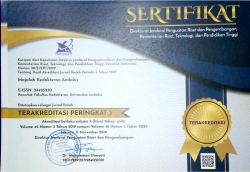Korelasi resistive index ginjal dengan proteinuria pada pasien diabetes melitus tipe 2
Abstract
Tujuan: Penelitian ini bertujuan mengetahui korelasi resistive index ginjal dengan proteinuria pada pasien diabetes melitus tipe 2. Metode: Penelitian ini dilakukan di Bagian Radiologi RS Pendidikan Universitas Hasanuddin Makassar pada Maret s/d Juni 2019. Penelitian ini adalah penelitian deskriptif dengan kajian potong lintang. Pertama dilakukan penilaian proteinuria, perhitungan eGFR, dan melakukan ultrasonografi Doppler sehingga mendapatkan nilai resistive index. Analisis data statistik melalui uji korelasi Spearman. Sampel penelitian ini sebanyak 82 sampel dengan 41 sampel disertai proteinuria dan dengan 41 sampel tanpa disertai proteinuria. Hasil: Penelitian menunjukkan korelasi kuat antara resistive index ginjal dengan proteinuria (r=0,449 dan r=0,551) dan memiliki hubungan yang signifikan (p<0,0001). Untuk korelasi resistive index ginjal dengan eGFR terdapat korelasi yang kuat (r=0,604 dan r=0,666) serta hubungan yang signifikan (p<0,0001). Dan terdapat korelasi yang cukup antara proteinuria dengan eGFR serta memiliki hubungan yang signifikan (r=0,449; p<0,0001). Simpulan: Semakin tinggi kadar proteinuria, maka semakin tinggi nilai resistive index ginjal pada pasien diabetes melitus tipe 2. Terdapat hubungan yang cukup kuat antara resistive index ginjal kanan dan kiri dengan eGFR pada pasien diabetes melitus tipe 2. Dimana semakin tinggi nilai resistive index ginjal, maka semakin rendah nilai eGFR (semakin tinggi stadium PGK).
Keywords
Full Text:
PDFReferences
World Health Organization. Global report on diabetes: executive summary. Geneva: World Health Organization; 2016. Available at [Link].
Aldukhayel, A. Prevalence of diabetic nephropathy among Type 2 diabetic patients in some of the Arab countries. Int J Health Sci (Qassim). 2017; 11(1):1-4. [PubMed] [PMC free article].
Fiorini F, Barozzi L. The role of ultrasonography in the study of medical nephropathy. J Ultrasound. 2007; 10(4):161–167. doi: 10.1016/j.jus.2007.09.001. [PMC free article].
Genov D, Kundurdgiev A, Pencheva V. Resistive Index for the Evaluation of Renal Damage in Diabetes Mellitus Type 2. Open Journal of Internal Medicine. 2018; 8(2):160-166. doi: 10.4236/ojim.2018.82016.
Mancini M, Masulli M, Liuzzi R, Mainenti PP, Ragucci M, Maurea S, et al. Renal duplex sonographic evaluation of type 2 diabetic patients. J Ultrasound Med. 2013; 32(6):1033-40. doi: 10.7863/ultra.32.6.1033. [PubMed].
Masulli M, Mancini M, Liuzzi R, Daniele S, Mainenti PP, Vergara E. Measurement of the intrarenal arterial resistance index for the identification and prediction of diabetic nephropathy. Nutr Metab Cardiovasc Dis. 2009; 19(5):358-64. doi: 10.1016/j.numecd.2008.07.003. [PubMed].
Viazzi F, Leoncini G, Derchi LE, Pontremoli R. Ultrasound Doppler renal resistive index: a useful tool for the management of the hypertensive patient. J Hypertens. 2014; 32(1):149-53. doi: 10.1097/HJH.0b013e328365b29c. [PubMed] [PMC free article].
Hanamura K, Tojo A, Kinugasa S, Asaba K, Fujita T. The resistive index is a marker of renal function, pathology, prognosis, and responsiveness to steroid therapy in chronic kidney disease patients. Int J Nephrol. 2012; 2012:139565. doi: 10.1155/2012/139565. [PubMed] [PMC free article].
Tublin ME, Bude RO, Platt JF. The Resistance index in Renal Doppler sonography: Where Do We Stand?. Am J Roentgenol. 2003; 180:885-892. doi: 10.2214/ajr.180.4.1800885.
American Diabetes Association. Standards of Medical Care for Patients With Diabetes Mellitus. Diabetes Care. 2002; 25(suppl 1):s33-s49. doi: 10.2337/diacare.25.2007.S33.
UKidney Internet School of Nephrology. EGFR calculator. [Internet]. BrightBean Solutions Inc; 2018. Available at [Link].
Nordström A, Hadrévi J, Olsson T, Franks PW, Nordström P. Higher Prevalence of Type 2 Diabetes in Men Than in Women Is Associated With Differences in Visceral Fat Mass. J Clin Endocrinol Metab. 2016; 101(10):3740-3746. doi: 10.1210/jc.2016-1915. [PubMed].
Yang L, Shao J, Bian Y, Wu H, Shi L, Zeng L, et al. Prevalence of type 2 diabetes mellitus among inland residents in China (2000-2014): A meta-analysis. J Diabetes Investig. 2016; 7(6):845-852. doi: 10.1111/jdi.12514. [PubMed] [PMC free article].
Hayashi T, Tsumura K, Suematsu C, Endo G, Fujii S, Okada K. High normal blood pressure, hypertension, and the risk of type 2 diabetes in Japanese men: The Osaka Health Survey. Diabetes Care. 1999; 22(10):1683-7. doi: 10.2337/diacare.22.10.1683. [PubMed].
Gray N, Picone G, Sloan F, Yashkin A. The Relationship between BMI and Onset of Diabetes Mellitus and its Complications. South Med J. 2015; 108(1):29-36. doi: 10.14423/SMJ.0000000000000214. [PMC free article].
Fallah M, Nafisi-Moghadam R, Nouri N. Relationship between Intra-renal Arterial Resistance Index (RI) and Albuminuria in Diabetic Patients. Irian Journal of Diabetes and Obesity. 2012; 4(1):7-10. [Abstract/FREE full-text].
Gulek B, Soker G, Erken E, Adam FU, Varan HI, Ada S, et al. The Usefulness of Renal Doppler Parameters in Chronic Kidney Disease: Is There a Cut-Off Value to Estimate End Stage Kidney Disease? Open Journal of Radiology. 2016; 6(1):18-23. doi: 10.4236/ojrad.2016.61003.
Bigé N, Lévy PP, Callard P, Faintuch JM, Chigot V, Jousselin V, et al. Renal arterial resistive index is associated with severe histological changes and poor renal outcome during chronic kidney disease. BMC Nephrol. 2012; 13:139. doi: 10.1186/1471-2369-13-139. [PubMed] [PMC free article].
Milovanceva-Popovska M, Dzikova S. Progression of diabetic nephropathy: value of intrarenal resistive index (RI). Prilozi. 2007; 28(1):69-79. [PubMed].
Iseki K, Ikemiya Y, Iseki C, Takishita S. Proteinuria and the risk of developing end-stage renal disease. Kidney Int. 2003; 63(4):1468-74. doi: 10.1046/j.1523-1755.2003.00868.x. [PubMed].
Imai E, Horio M, Yamagata K, Iseki K, Hara S, Ura N, et al. Slower decline of glomerular filtration rate in the Japanese general population: a longitudinal 10-year follow-up study. Hypertens Res. 2008; 31(3):433-41. doi: 10.1291/hypres.31.433. [PubMed].





















